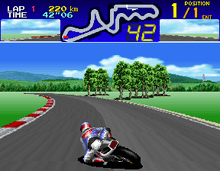Suzuka 8 Hours (video game)
Coca-Cola: Suzuka 8 Hours[lower-alpha 1], also known as simply Suzuka 8 Hours, is a 1992 motorcycle racing arcade game developed and published by Namco. It is based on the real-world racing event of the same name, a popular racing venue in Japan. Players control a racer using a handlebar controller and must race against computer-controlled opponents while remaining in first place. It ran on the Namco System 2 arcade hardware. A direct sequel, Suzuka 8 Hours 2, was released a year later.
| Suzuka 8 Hours | |
|---|---|
 Promotional sales flyer | |
| Developer(s) | Namco |
| Publisher(s) | Namco |
| Series | Suzuka 8 Hours |
| Platform(s) | Arcade, Super Nintendo Entertainment System |
| Release | |
| Genre(s) | Racing |
| Mode(s) | Single-player, multiplayer |
| Cabinet | Upright |
| Arcade system | Namco System 2 |
Gameplay

The game was made available in two-player cabinets featuring two monitors and two replica motorcycles; players accelerate their bikes by holding down the throttle grip and brake by using the brake lever, while steering is accomplished by physically leaning the bike left or right. The arcade game can be played by up to eight players simultaneously by linking four two-player cabinets together, and the players must complete an entire lap of the track within a preset time limit - and upon completion of a lap, the time is extended for all players in the race. The first player to complete a preset number of laps (between 3 and 6 and adjustable by the arcade operator) wins the race; as in Final Lap and Dirt Fox (the latter of which was only released in Japan), if they manage to finish the race in less than a preset time, they have the opportunity to enter their initials upon the game's "best time" (as opposed to high score) table.
SNES version
Suzuka 8 Hours was later ported to the SNES, in 1993 by Arc System Works; the game simulates the actual eight-hour race as eight "virtual hours", or over ninety "real-time" minutes. The object is to complete as many laps as possible before the time runs out - and if it does, the timer starts going up again (as penalty time) and the next trip to the finish line ends the race. Upon reviewing this version, GamePro criticized the absence of sound from CPU competitors' engines and the "distracting" music; however, they praised the responsive controls and "sharp" graphics.[1]
Reception
In Japan, Game Machine listed Suzuka 8 Hours on their July 1, 1992 issue as being the most-successful upright arcade game of the year.[2]